#moroccan carriage
Explore tagged Tumblr posts
Text

1 note
·
View note
Text

Affordable Tents for Moroccan Theme Outdoor Events
product link:- https://dst-international.com/portfolio-items/affordable-tents-for-moroccan-theme-outdoor-events/
For More Information:- Contact on WhatsApp +9186753-33339/ +9198152-24101,+9176965-22022/ +9198039-844444 Email-id:- [email protected]
#wedding #weddings #tent #tents #weddingtent #moroccantheme #outdoor #outdoorwedding #event #events #weddingdecoration #weddingdecor #weddingideas #wedingevent #eventplanner #weddingplanner #affordabletents #weddingset #affordableprices #affordablesize #factoryate #manufacturer #exports #exporters
We manufacture of all types of mandap - Fiber mandap, Wooden mandap, Metal mandap, Crystal mandap. We have also make stages –reception stages, Asian wedding stages, mehndi and haldi deco stages. We have different types of panels- fibre panel, candle wall , mirror panel, metal arcs and backdrop curtain. We are also manufacturer of Wedding furniture - Wedding sofa, mandap chairs, bridal groom chairs , Centre table , swings, settee, wedding carriages , bridal doli and Rath.
#decor#weddingplanners#weddingideas#manufacturer#weddingdecor#furniture#home decor#online#exporters#wedding
0 notes
Text
Enchanting Morocco: A Family Adventure from Casablanca
Day 1: Arrival in Casablanca, Morocco
Upon arriving in Casablanca, you will be greeted and transferred to your hotel overlooking the medina. This marks the beginning of your adventure, setting the stage for an unforgettable family tour through the rich cultural tapestry of Morocco.
Day 2: Casablanca | Moroccan Metropolis
Embark on a tour from Casablanca to explore the city's highlights, including a visit to the magnificent Hassan II Mosque, which majestically extends over the Atlantic Ocean. Marvel at the vibrant Habous Market before journeying overland to Fez. Here, you’ll stay in a traditional riad, allowing your family to immerse themselves in the local culture and enjoy the evening at leisure.
Day 3: Fez | Magical Medina & Ancient Drum Making
Experience the charm of Fez el-Bali (Old Fez), the cultural heart of Morocco. Wander through the medina's narrow lanes and visit the historic Karaouine University and the 14th-century Attarine Madrasa. During this family tour, you’ll also meet a local artisan who will teach you how to make and decorate your own drum, culminating in a fun drumming session that immerses you in Moroccan musical traditions.
Day 4: Fez | The Wilds of Ifrane
Start your day baking traditional Moroccan bread and cookies with a dada (family cook). After enjoying your creations for lunch, venture into the natural landscapes beyond Fez. Visit the unique village of Bhalil and the alpine city of Ifrane, home to lush forests and Barbary macaques. This portion of the tour from Casablanca offers a blend of cultural immersion and nature exploration, ideal for family adventures.
Day 5: Volubilis & Meknes | Roman Ruins & Imperial Treasures
After breakfast, drive to Volubilis, a UNESCO World Heritage Site known for its well-preserved Roman ruins. Discover its triumphal arches and intricate mosaic floors. Continue to Meknes, a 17th-century imperial city built by Sultan Moulay Ismail. Visit the Bab Mansour gateway and the royal stables. Later, proceed to Rabat, where you can relax at your charming hotel.
Day 6: Rabat | Exploring Morocco’s Capital
Join your private guide for a tour of Rabat, highlighting its cultural influences and well-preserved Moorish relics. Visit the Hassan Tower and the mausoleum dedicated to Mohamed V. In the afternoon, travel to Marrakech, the "Pearl of the South," and settle into your luxurious resort.
Day 7: Marrakech | Enchanting Medina
Discover the secrets of Marrakech, starting with a morning tour of its medina. Visit the Koutoubia Mosque and explore the vibrant Djemaa el-Fna square, filled with vendors, fire-eaters, and musicians. Dress up in traditional attire at the Ali Baba Cave shop and have a photographer capture your family’s adventure. Explore the souks and enjoy the lively atmosphere of this fascinating city.
Day 8: Marrakech | Beyond the City Limits
Join a chef for a culinary experience on a farm outside the city. Pick fresh vegetables, learn to cook a traditional tagine, and enjoy lunch. Choose from various activities such as a horse-drawn carriage tour of Moroccan gardens, an ATV tour by Lalla Takarkoust lake, a camel ride through the palm grove, or a bike ride around the ancient city walls. Later, transfer to the airport for your homebound flight, concluding your enriching family tour and tour from Casablanca.
0 notes
Text
Day 10 Sunday, May 26th
Marrakech, Moroccow
We have arrived in Marrakech! It is what most people think of when they picture Morocco. The topography changed from green and trees to red clay and dessert. The temperature also increased so it was in the high 90’s.



It was a long drive from Fes to Marrakech and it took most of the day. We had several rest stops along the way which included lunch at McDonald’s. It was nice to have familiar food and nice and free restrooms, something that you quickly learn to appreciate here.
During the drive, we watched an Alfred Hitchcock movie, The Man Who Knew Too Much, with Doris Day and Jimmy Stewart, because the scene in the restaurant was filmed in the same restaurant we were to have dinner. When we got to the restaurant we all recognized it from the film.



Dinner was a typical Moroccan meal and accompanied, again, by belly dancers. It was an enjoyable time.



Then we walked through the market and square, which was amazing. All crowed together were fruit stands, shopping stalls selling nearly everything you could want, tourists, locals, horse drawn carriages, performers and more! It was people everywhere!
0 notes
Photo

Moroccan theme party
Whether you are looking for Moroccan theme party we will artistically transform your space into an Moroccan theme setting from the tales of nights. Our authentic furniture, tents, lighting, props, and wedding carriages for a perfect set up .
We specialize in setting up the best decor for Moroccan party rentals and lounge furniture in Los Angeles either in a draped tent with vibrant colors or elegantly displayed indoor or outdoor for that best 1001 Arabian Themed night to be remembered by all attendees. We carry authentic Moroccan rentals props, tents, lounge furniture, rugs, poufs, lounge tables, bar, decor, lanterns, chandelier, low sitting brass tray table, daybeds, arches, DJ Stage, Backdrops wall panels, Lounge kilim pillows, Centerpieces, Table Overlays, Arches, Screen Dividers,water fountains, carriages, love seat, thrones chairs for Indian Bollywood weddings, Arabian nights, bohemian decor. A full line of Authentic Moroccan dresses and outfit for men, women and children.
#Party rentals los angeles#Event rentals los angeles#Wedding rentals los angeles#Party rentals in los angeles ca#Moroccan arches#Moroccan backdrops#Moroccan Carriage#Moroccan loveseat#King and Queen chairs Thrones#Dj stage rentals#Cocktail table#Cocktail lounge table#Choupa#Moroccan brass table#House warming theme party#Moroccan tent draping#Bedouin lounge and rugs#Arabian night Theme party#moroccan theme party#arabian nights theme party#anthony party rentals#moroccan party#moroccan party decor#party rentals san fernando valley#moroccan party supplies#moroccan theme decor#arabian nights party decorations#party rentals van nuys#moroccan theme party decorations#arabian nights party supplies
1 note
·
View note
Text
yesterday we walked from the restaurant to the centre which was already like 30 minutes and then i broke my mask and i was so full i felt like any moving carriage would make me throw up so i walked home (it’s a safe walk) for another 25 minutes and these dudes were like hi are u moroccan and i was sending strong “oh wow suddenly i’m very busy on my phone leave me alone” vibes so one of them said “no? ok guess i’ll perish” and i almost broke out of my character and laughed... to my defense they were hot but like i have 2 rules: 1. don’t talk to strangers past 7pm bc i don’t wanna know what u want from me i just know i clocked out mentally from interacting with anyone i don’t already know and care about and 2. don’t talk to anyone who asks me where i’m from right off the bat even tho they were moroccan too like what is it to you weirdo... “are u moroccan? yes? ok can i have ur number?” literally what kind of logical leap? i need to start lying about my ethnicity. i’m from mars this week
28 notes
·
View notes
Text
Hello! 😀
Do you want to spend 10 days in one of the liveliest cities in the world? If yes, come and join my trip! September is a perfect period of the year to visit New York🗽🤩.
For the trip page, click here
The trip to New York is from 12th to 21st September 2022.
New York City 🗽 has so many attractions, so I have planned this trip so that we can see almost all the famous attractions in this amazing city🤩:
Top of the Rock
Tour of the Rockefeller Center
Tour to explore Grand Central Station
Times Square
Ferry tour to see the famous Statue of Liberty and also Ellis Island
Wall Street
Solomon R. Guggenheim Museum
Saint Patrick's Cathedral
Bryant Park
New York Public Library
SUMMIT One Vanderbilt
Museum of the City of New York
Harlem
9/11 Memorial and the World Trade Center
Brooklyn Bridge
Jane's Carousel
Intrepid Sea-Air-Space Museum
Vessel at Hudson Yards
Asylum Theatre to see an off-Broadway show, which is 'Titanique'
Washighton Square Park
Greenwich Village
Museum of American Art
Walk the High Line from the Whitney to Chelsea Market
The Metropolitan Museum of Art
Central Park
Brooklyn Botanic Garden
Deno's Wonder Wheel Amusement Park
Museum of Modern Art
American Museum of Natural History
Apollo Theater (Amateur Night show)
The trip includes many tours as well. Like Big Bus New York Hop-on Hop-off tour 🚍, NYC horse-drawn carriage ride tour 🏇 and tours for all attractions that need a tour to be explored!⛴️😍
In addition to this, we will eat in Must-Eat Restaurants in NYC 🗽 during the 10 days.🥘🍜🍝😍
I am looking for a maximum of 5 TripMates that are excited to live an unforgettable experience, explore the most famous attractions in NYC 🗽 and are ready to live this adventure and have fun!🤩🤩🤩
If you want to learn more about it, check the trip page
About me: I am Dounia, 26 years old. I am Moroccan and an electrical engineer. And I work in Network Marketing now.
You can send me DM here, or text me on WhatsApp
I am looking forward to connecting with people from anywhere around the globe.🙌🥰
#nyc#tourists#trip to new york#exploring#destination#travellers#brooklyn#new york city#manhattan#new york
2 notes
·
View notes
Photo



Found and unpacked all of my perfumes. They've been missing since I got to Georgia. Finally located them in a box.
I have so much....................
WHAT I HAVE:
ALKEMIA
Full Sprays: Miel de Sauvage et Tabac (all star best) Old Books and Fresh Flowers (love it, new one, very excited) As Dark Things Are Meant To Be Love
Alchemy Special Edition Bottles: Love & Luck Alchemy 2021 Flower Moon Alchemy 2019 and 2020 Winter Alchemy 2020
Full Bottles: The Prophet and the Wanderer Burning Roses Dustsceawung The Decadents Alkemia's fixative rollerball (best fixative!)
FOR STRANGE WOMEN
Labyrinth Palo Santo + Amyris Astral Projection Rose + Cypress (my favorite scent of all time, was a limited run like 2 years ago) Crushed Violets Antique Settee Midwest Moongarden Northern Moon Garden
SOLSTICE SCENTS
Smokewood Apiary (the best honey-based scent ever) Heart of the Night empty Smokewood Apiary Black Forest
MY FUCKING STASH PILE OH MY GOD (including what i can afford to destash)
Alkemia:
Gateau d'Anniversaire (can destash) The Gentlemen's Adventurer Club Absinthe and Laudanum in the Afternoon Old Books and Fresh Flowers (can destash) The Pleasures of Love Sultan's Reverie (ugh i loved this one, but it sold out before i could buy) Surrender of Solitude (can destash AFTER I BUY IT) Crown of Success Rara Avis (wish i bought this one) Zephyr (WISH I BOUGHT THIS ONEEEE) Caveau Des Innocents The Golden Bough (can destash) A Darkness Shining in Brightness (can destash) Les Mysteres (can destash) Persian Tearoom (can destash) Big Sur The Spicetree (can destash) The Prophet and the Wanderer (can destash) Amour Conjure (can destash) The Yellow Book Green Witch Moroccan Tea (can destash) Fume Oud a la Vanille Silver Sky Enkindled Spring Enchantress (can destash) The Romance of Lust (can destash) Black Roses (can destash) Sigil The Sybilla Forest Rose Bois D'Ambre La Flamme Aphrodesia (can destash) NEW: O Tea! Kashish (!!!!!) Misdeeds After Midnight Come To Me (!!!!!!!!!!!!!) Infamous Muse (I just put this on and wow????) Book of Twilight In A Railway Carriage
Solstice Scents:
Incensury (can destash) Sirocco (can destash) Witch's Cottage (can destash) After the Rain Grey's Cabin (can destash) High Desert (can destash)
For Strange Women:
Astral Projection (!!! should destash!)
20 notes
·
View notes
Text
Pursuing family ghosts in Morocco
' I was never a Moroccan Jew, only a Jew in Morocco', Irin Carmon's grandfather tells her. He has put his past behind him, but it is a past, full of ghosts and magical thinking, that Irin is eager to reconstitute. Here is her lyrical account of her visit to Morocco in Tablet magazine. (With thanks: Shulamit)

Synagogue in Marrakesh (Photo: Aaron Vincent Elkaim) My grandfather does not remember himself as a dupe. He remembers three beatings on the road to Israel. The first beating came in 1948, when he would have been about 15, he went to buy a newspaper and saw that the Jews had occupied Jaffa. A boy his age, he tells me, saw him smiling, and demanded, “Tu es satisfait? De quoi?” Yes, I am satisfied, he replied, “Qu’est-ce que tu veux?” What do you want? My grandfather began backing into an alley. The second beating occurred two years later, at the border between Morocco and Algeria. He had spent two weeks salary on laissez-passer papers to cross the border at Oujda, which was letting its Jews leave for what was by then the State of Israel. He was around 17. At the border, they told him to empty his pockets and turn around. He remembers the kick that knocked him to the floor and the 24 hours in jail for having what turned out to be false papers. A member of the Jewish community bailed him out as the ones before him had been, and put him on a train to Casablanca. There, he was taken in by relatives and wrote letters for illiterate laborers to earn his fare home. The third beating was in Casablanca a few months later. By this time, he had begun to drive a sardine truck between Agadir and Casablanca, a well-paying job. The clandestine network was still the only way for the Jews to leave. He heard about a travel agency that was a front for the Mossad, run by a Madame T. Each time he came to the travel agency to ask for her by name, he was told no such woman worked there. For three mornings he stood outside and watched as the clerk went for coffee and went up to the second floor. On the fourth day, when the clerk left, he went inside and went upstairs. There a woman sat. “Are you Madame T?” he asked. “I want to go to Palestine.” Israel was a forbidden word. “You have the wrong address,” she replied. But then she relented. At 17, she said, he was too old for the youth aliyah and too young for the army. He could, however, do agricultural training in France. Anything to leave Morocco, he replied. “Come back in a few days,” she said. “I’ll tell him to let you up.” When the day came, my grandfather put on his best suit and in the crowded streets of Casablanca, bumped shoulder to shoulder with a boy around his age. “Pardon,” my grandfather said, but the boy turned around and smacked him hard in the face. Blood seeped into his suit. When it became clear that the stony faced Meir was not going to fight back, the other boy became enraged and began to yell that the Jew had cursed Islam. Unluckily for him, another Muslim who was sitting nearby had witnessed the entire encounter. Rising from his chair, the man slapped the boy in the face. “You’re a liar!” My grandfather did not clean his suit or his face before he went to see Madame T. that day. “You see why I need to leave Morocco?” he grinned. She did. Here were his instructions: At 4 p.m. he was to go to the Place de France and enter a horse-drawn carriage. The carriage took him to a bus that was already full of boys and girls. The bus took him to a house surrounded by trees and an orchard. At 2 in the morning they were awakened and taken to an abandoned port, where they sailed—at first, smuggled below deck—until Gibraltar. After 10 months in Toulouse and a month in Marseilles for agricultural training, he was on a ship to Israel. The way he tells the story, he had to refuse the calls of sirens, women who sought his protection and who would tie him down. The family where he stayed in Casablanca had tried to trick him into marrying their daughter, such that his mother showed up all the way from Agadir to wish him well on his engagement. He was so furious he walked out on her then and there to begin sleeping on a park bench until they let him go to the promised land. Two weeks in Place de France. He still has a postcard of the bench. The woman on the boat from France who had asked for his protection; he told her she would get it on his terms only, which were cold and dutiful terms that demanded she keep her distance. But he arrived in Israel reborn. “I became a child again only in Israel.” Read article in full Al-Jazeera programme on Morocco A partial paen to coexistence in Morocco Keep calm and carry on - in Mogador
Point of No Return
14 notes
·
View notes
Text
Rio de Janeiro, Brazil - Week 1
The bus ride from Paraty to Rio was easy and uneventful. The road runs along the coast, but unfortunately the view is mostly obscured by overgrowth. I caught some dramatic, beautiful glimpses, but Brazil could learn from California and Australia. Upon arrival at my Ipanema AirBnB, I took a breath then settled in for two weeks of adventure....
My friends Scott and Tony had left Paraty a couple days early to come to Rio, so I met them for drinks and dinner Saturday night. We walked to a lively, popular-with-millenials section of Leblon and ate dinner at CT Boucherie, an established steakhouse-ish restaurant that was fantastic (and a great value for how much we ate and drink). Those guys had had a big night on Friday so we all turned in early.
And it’s good we did since Scott had a full day planned for us. We started at Parque Lage for breakfast at their famous restaurant. It occupies the courtyard of a crumbling mansion (now an art school) and sits just below Rio’s most famous landmark, Christ the Redeemer. It’s a setting made for Instagram, and everyone certainly took advantage of that. The food was pretty tasty for a place that could easily half-ass it. After breakfast we walked around the park a bit and saw our first monkeys!
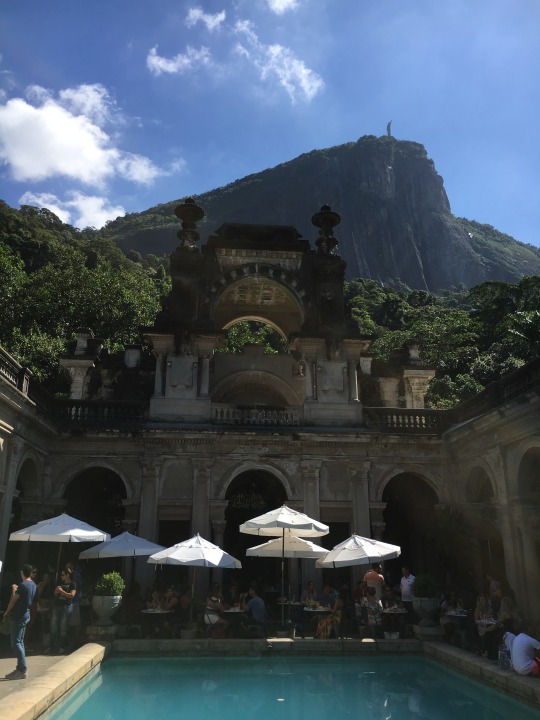


We then walked through Jardim Botanico, which appears to be the Beverly Hills of Rio. We walked through the Botanical Gardens as well, which are lush and beautiful. I think the most striking element were the massive tree trunks, some of which formed walls rising several feet above the ground.
From here we traveled back to Ipanema’s Praca General Osorio for the famous “Hippie Fair”, an arts and crafts market. I’m not sure what the big deal is-- it seems like every other crafts market I’ve seen. Afterwards the guys went to the beach, but I needed some literal chill time in front of a fan, so I lay low at my apartment for a while. We met up again for dinner at Zaza, a delicious Moroccan restaurant. It was the guys’ last night, but we were all pretty beat, so we called it early after a couple more beers.
Monday was shopping day, both clothes and groceries. I am not a beach person, and I was not prepared for how beached out Rio is. Even at nighttime in nice restaurants, people are in t-shirts, shorts and flip-flops. I needed some more beach wear to fit in (tho I only ended up finding one pair of shorts I liked). I met up with the guys again for lunch at Barraca do Uruguai, the most famous stand at Ipanema beach selling delicious meaty sandwiches. They had to get to the airport so we parted ways and I found myself all alone in Brazil....
On Tuesday I committed to the hard work of tourism. In the morning I took the metro to Centro, the historic center of Rio. I emerged at Rua Uruguaina into a hectic street bazaar. It was initially unnerving but a nice break from laid back Ipanema. Once I got my bearings I climbed up to Morro de Conceicao, a very old, Lisbon-esque street with cute (if shabby) townhouses, and then down to Praca Maua, the waterfront area that was revitalized for the 2016 Olympics. I first visited the Museu de Arte do Rio, housed in a beautiful colonial building attached to a gleaming modern annex. The view over Guanabara Bay is fantastic. The museum was showing two exhibits, one (”Mulheres”) featured women artists and had a lot of compelling pieces. The other was a history of samba. Once again I couldn’t understand the Portuguese captions, but there was enough music, video and glamorous visuals to make it fun nonetheless.


I walked across the plaza to Museu do Amanha (”Tomorrow”), a very modern “science” museum with a lot of interactive video displays and flashy installations for these selfie/social media loving Brazilians. The science was a bit thin; it starts with a brief history of the universe then focuses on humanity’s impact on the planet, for better and worse. But it was engaging.


I then hiked up another hill to the Mosteiro do Sao Bento, a monastery that is one of the city’s oldest buildings. Its plain, humble exterior belies an over-the-top opulence inside, a theme I found in every church I saw that day. Those early Portuguese settlers loved ornate, gilded wall reliefs like you would expect from Louis XIV.

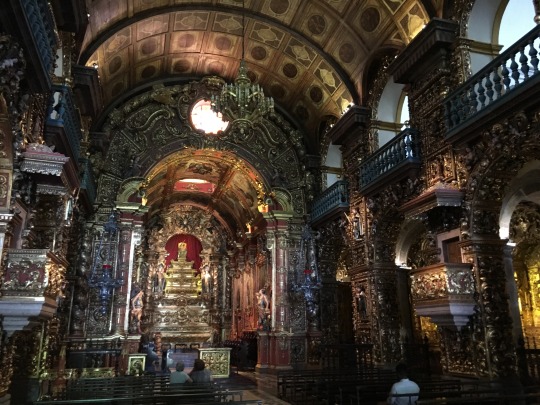
After a tasty chicken burger at the hip Cozinha Mironga I continued toward the waterfront to Igreja de Nossa Senhora Candelaria, the biggest of the city’s historic churches. The surrounding area houses lots of current and former government buildings, most of them imposing neoclassical edifices or fanciful Baroque colonial desserts (or both). I saw the Centro Cultural do Banco do Brasil (tho I skipped the current exhibition of Dreamworks art), Igreja de Nossa Senhora do Carmo da Antiga Se (which served royal functions when the Portguese throne decamped to Brazil) and Paco Imperial (the one-time royal palace). From there I walked through the extremely underwhelming (but historic) Arco de Teles into Travessa do Comercio, a charming cobblestone street of colonial townhouses, now home to outdoor cafes.
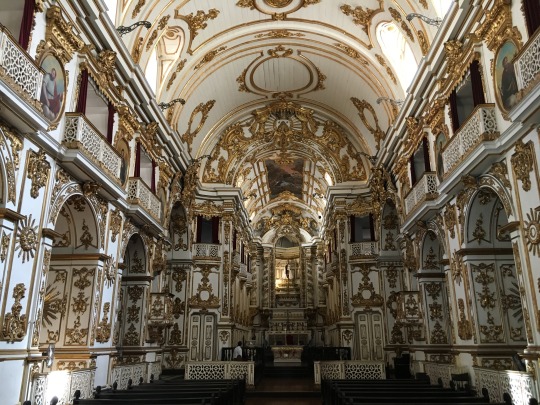
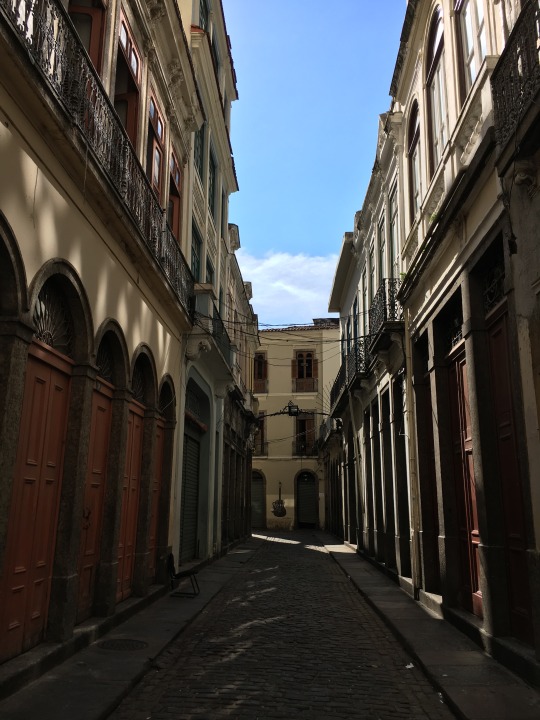
From here I cut across the hustling narrow streets of Centro to Largo da Carioca, a plaza surrounding by some atrocious 1960s skyscrapers (tho the Petrobras HQ is a marvel) and dominated by a very old church, Igreja Sao Francisco da Penitencia e Convento de Santo Antonio (phew). It’s beautifully restored and wins the gaudiest award in a very tough category. Not one inch of that chapel was left ungilded, an odd choice for an order who has taken a vow of poverty.
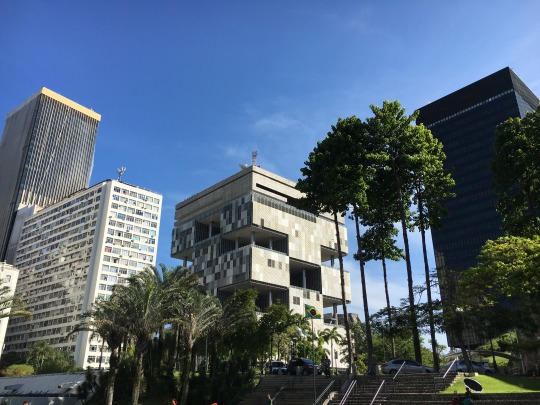

I then headed back up to Real Gabinete Portugues de Leitura, or the Royal Reading Room. It’s basically a library, and one of the most stunning I’ve ever seen. It’s three stories of books (over 350,000) in sumptuous but tasteful, muted decor. You can feel the knowledge surrounding you, and it makes you yearn to have more of it.
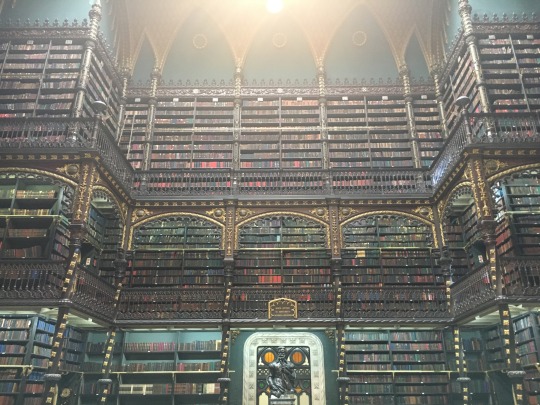
From there I veered west into Saara, a small grid of narrow streets that serves as an outdoor market and bazaar. You can probably find anything you need here and at a good price. At the end of it I found Campo de Santana, an elegant park with an odd assemblage of wild beasts-- cats, ducks, some sort of large fowl, and a cute, big rodent creature (capybara?). That was enough for one day so I headed back to Ipanema, had a big, tasty, cheap dinner at Frontera and went home to bed.
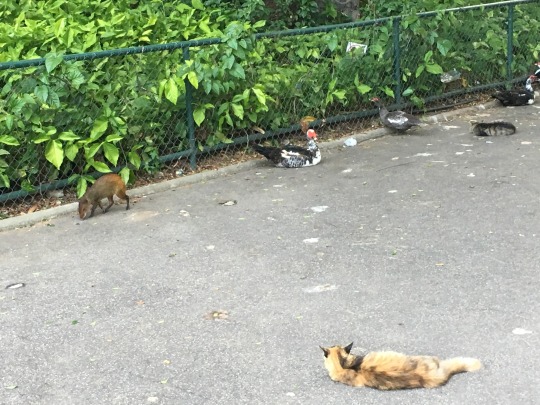
On Wednesday I headed back down to Centro to finish my tour. I started at the Museu Historico Nacional. I have a particular interest in history museums because a) I think it’s important to have some background and context when you travel; b) I’m a history nerd; and c) they are difficult to do well since good history requires a lot of text, which is not well-suited to a museum. Rio’s history museum is... decent. Housed in a well-maintained old fort, it could definitely use some refurbishing and some more engaging exhibits. After a respectable space telling the story of the indigenous people, it mostly focuses on the leaders and elites who steered the country from a Portuguese (and Dutch and French) colony into an independent republic. It has little to say about slaves, and I found no mention of the military dictatorship that ruled from the sixties to the eighties. (This is especially problematic given the current president’s favorable, revisionist view of the dictatorship.) But otherwise the narrative seems fair and accurate, if not thorough. It has almost no weighty artifacts, like original documents or “this was the actual thing that person used” items. It is mostly full of examples (of china, jewelry, slave shackles, etc.), paintings (many immense) and busts. Two awesome exceptions are a large array of carriages and early cars spanning three hundred years and an actual historic apothecary that was moved into the museum when it went out of business. I also appreciated that all of the displays had English translations tho they were riddled with errors. It made me wonder why the museum wouldn’t have them proofread before printing them up in a permanent exhibition.

From here I walked back to Praca Floriano (aka Cinelandia) which is the heart of downtown. The plaza is fairly non-descript, but it’s surrounded by some of the city’s most beautiful buildings: Theatro Municipal, Bibliolteca Nacional, Museu Nacional de Belas Artes and Camera Municipal. It was so stunning I stopped for lunch on the square and came back to see it lit up at night (when apparently the navy was attending the opera...).
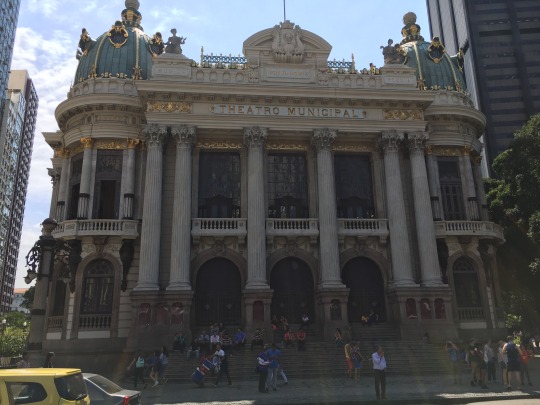
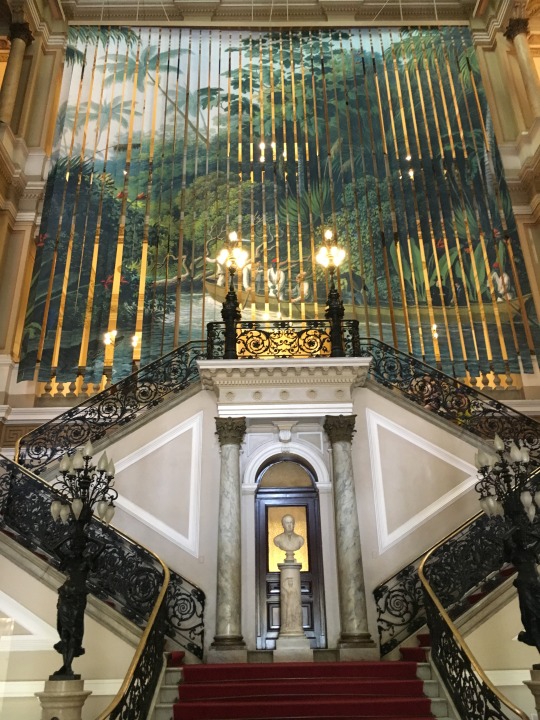

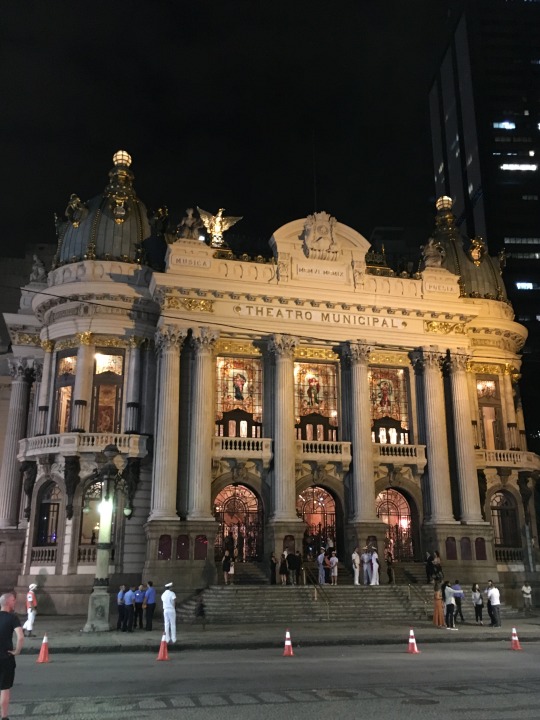
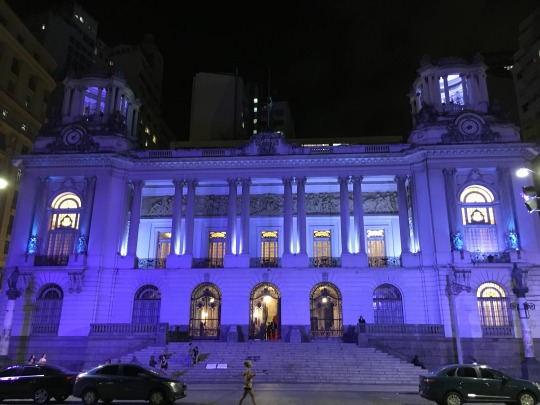
After lunch I continued west into Lapa, past the iconic Arcos (an old viaduct) and the peculiar Catedral Metropolitana de Sao Sebastio. It’s a brutalist cement cone modeled after Aztec pyramids, and it looks nothing like any church I’ve ever seen (tho not far off from St. Mary’s in San Francisco, aka “The Washing Machine”). After my initial shock and repulsion, I found it growing on me, if only for its boldness and break from tradition. It’s most famous for the tall stain-glassed windows (which are impressive in their size if not beauty), but what stood out to me was the main crucifix. It’s surprisingly small and suspended in the center of the cone about 30 feet above the altar. Jesus looks so vulnerable and alone, floating in an empty void. Of all the gory crucifixion scenes I’ve seen, this more than any other moved me and actually made me sad to think about Jesus’ plight.


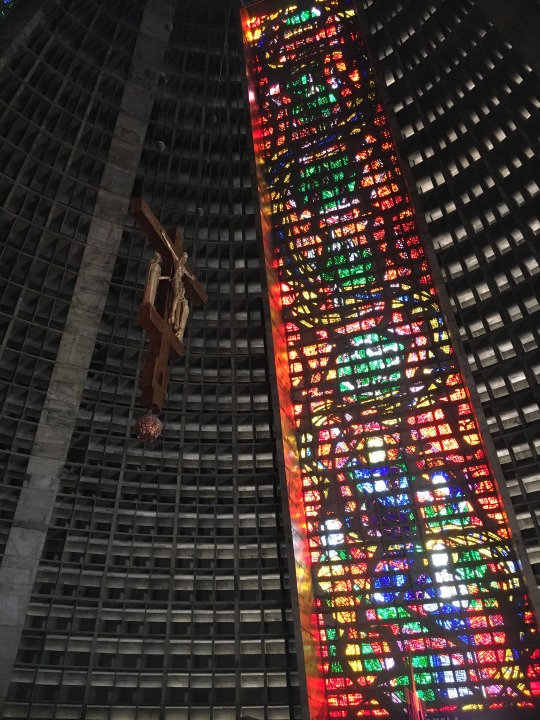
I then ventured further into Lapa. Nowadays it’s best known for its rowdy nightlife, and some of the bars were just starting to open up. Like much of Rio (and many Latin American cities), the area had traces of better days but now mostly looks decrepit. I made my way back, under the Arcos and headed to Cinelandia to catch the train home.
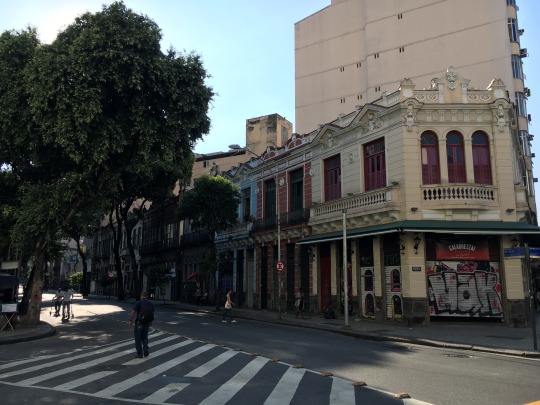
Thursday was considerably less ambitious. After a late start, I took the metro to Botafogo. Amid the usual urban grit of Rio are several beautiful old colonial mansions (as well as a notorious favela). I believe it was once an upscale artsy neighborhood that fell into decline, but some of the old buildings have been restored as museums or work spaces. Unfortunately, like so much of the city, they are hidden and inaccessible behind tall walls and fences. One beautiful exception is the Fundacao Casa de Rui Barbosa, once home to a famous writer and politician, now a museum. I didn’t go inside but the gorgeous grounds around the home are open to the public and look like a miniature botanical garden.
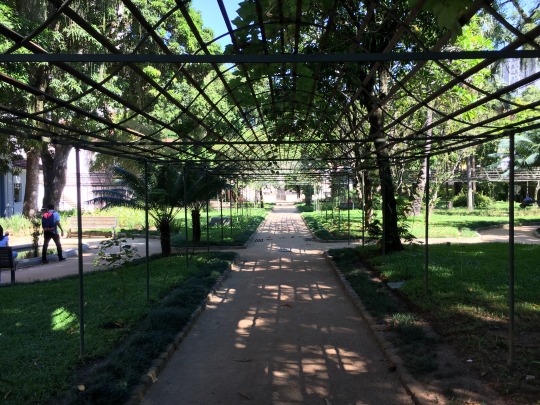
I made my way toward the next neighborhood, Humaita, and stopped at Cemiterio Sao Joao Batista, the final resting place for some of Brazil’s most famous residents. It’s quite beautiful and dramatic under the watchful eye of Christ the Redeemer. My last stop was Cobol do Humaita, a food market and dining hall, which are always pleasant to wander. The sun was going down so, after six days in Ipanema, I figured it was time to see the sunset on the beach. Obviously Rio faces East but the light is still nice.
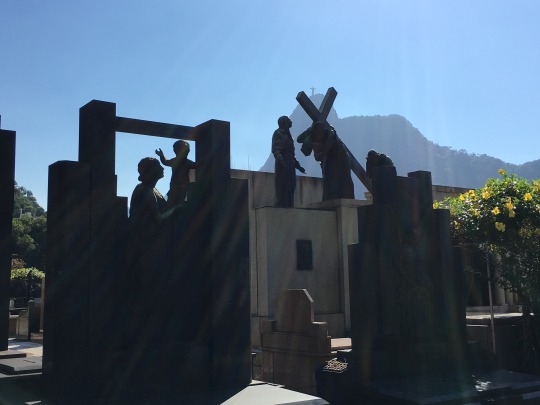
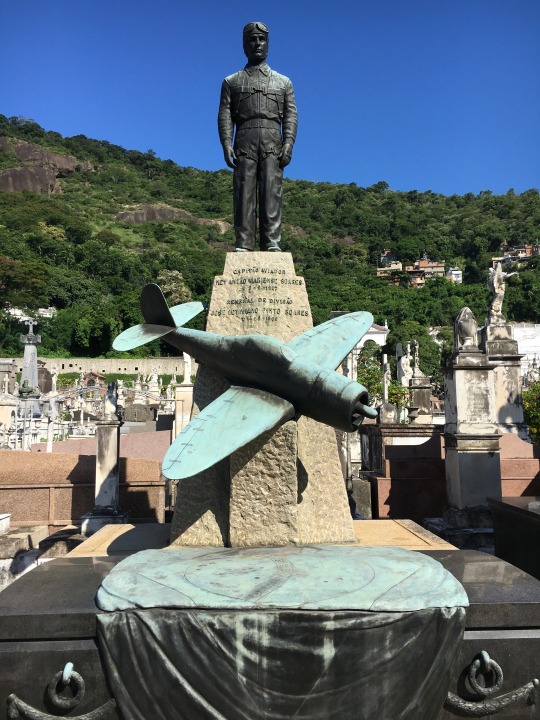

Friday turned out to be my most ambitious day and, painfully, the hottest so far. I returned to lovely Cinelandia and Lapa and visited the famous Escadaria Selaron, a public stairway that has been covered in a colorful tile mosaic in tribute to the people of Brazil. It’s pretty, fun and festive and swarming with tourists. Fortunately most people turn around at the top (if they get that far) instead of continuing into the beautiful Santa Teresa neighborhood. Like Botafogo, it’s full of charming old homes in various states of (dis)repair. But these are not walled off. And they run the gamut from cottages to palaces, so there is a lot of variety, both in architecture and culture. It reminded me of Russian Hill and Telegraph Hill. Also, this being a very steep hill, there are stunning views of the city and the bay from everywhere.


There is not much to do in Santa Teresa besides admire the loveliness, which probably helps keep the tourists away. Parque das Ruinas is the main attraction-- a crumbled mansion once owned by a salon-hosting socialite intellectual. It really feels like ruins, but staircases and walkways have been installed and the surrounding grounds turned into a park. The views from the top are spectacular. The small museum next door (Museu da Chacara do Ceu) hosts a private collection. It sounded interesting but appeared to be closed for construction.



I continued walking through the main commercial area which hosts some charming little boutiques, restaurants and bars (as well as a makeshift barber and a bar perched out on one of the viewpoints). I stopped for fantastic feijoada at Bar do Mineiro and more beer at the historic Bar do Gomes. Then, rather than walk all the way back down, I opted for the bonde, a cute little cable car that runs up and down the hill.



With a little daylight left, I headed back down to Botafogo and then over to Urca for one of Rio’s premiere attractions: Pao de Acucar (Sugarloaf Mountain). It stands tall at the north end of Copacabana and offers stunning views over the entire city and bay. It’s accessible by a sequence of two cable cars (gondolas), teetering at dizzying heights. It was crowded, as I expected at sunset, but not actually that bad. I stayed up there a while soaking in the “Marvelous City” and, like everyone else, taking tons of photos.


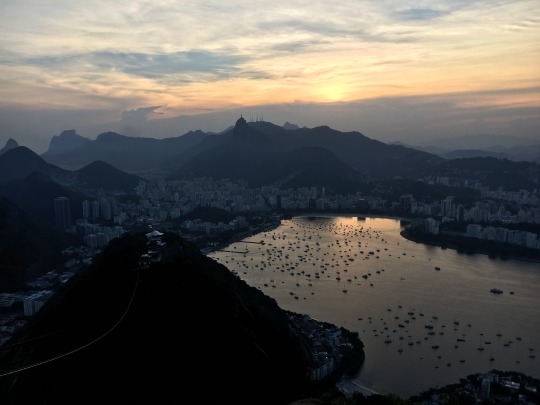
It was my first Friday night in the city, and I had nothing to do, which would have been a shame. But a guy I had been chatting with invited me to Paraiso do Tuiuti, a samba school. I demurred, concerned that I would not understand the instructions in Portuguese. But my friend then explained that it’s not a school so much as a club that performs sambas. The schools are formed in the favelas and compete at Carnaval every year. Friday night Paraiso was having a big birthday party and putting on a show for their friends.
The Paraiso clubhouse is across the street from Feira de Sao Cristovao, a kind of permanent country fair. It’s home to dozens of stalls selling all sorts of stuff, but at night, it’s mostly just restaurants and bars with a lot of karaoke. There is also a main stage with the kind of cheesy acts you would expect at a fair. And the crowd was overwhelmingly under 30, maybe 25. It was cute good times but I was not sorry to leave when my friend arrived.

The Paraiso do Tuiuti building is a big auditorium, not unlike a high school gym. A large samba band was in full swing in the corner of the mezzanine, and various people in uniforms, outfits and costumes were milling amongst the hundreds of guests. It all felt very festive, intimate and personable. A little later the performances started. My friend explained that each year at Carnaval each school performs a new samba and competes for first place (the schools are also organized like sports leagues with a top tier, mid tier, etc.). Paraiso do Tuiuti was performing their greatest hits that night in honor of their birthday (with songs going back to the 80s), and once they were done, a couple other schools-- Estacio de Sa and Mangueira (last year’s winners)-- performed as well. The whole experience was phenomenal and unforgettable-- the rhythms, the leg work, the costumes, the energy. It was a fantastic, only-in-Brazil night that a tourist can only hope to stumble upon.

Since I did not get home until 6am, Saturday and Sunday were my lazy days off before I returned to the tourist trail the next week....
1 note
·
View note
Text
Spain is the most welcoming country in Europe for migrants. Will it last?
By James McAuley and Pamela Rolfe, Washington Post, October 28, 2018
MADRID--When the migrant surge began in 2015, Western Europe was welcoming.
Cheering crowds greeted refugees arriving by train in European cities. “We can do it!” German Chancellor Angela Merkel urged on her countrymen in their generosity. Swedes scrambled to help new arrivals obtain housing and medical care. Italians began a massive search-and-rescue patrol effort in the Mediterranean.
But since then, much of Western Europe has closed its borders, turned away rescue ships and thrown support behind anti-migrant politicians. Even as the numbers of new arrivals have decreased to pre-2015 levels, migration has propelled the election of populist factions in Austria and Italy and threatened the stability of establishment parties in France and Germany.
The most visible exception is Spain.
Just over seven nautical miles from Africa, Spain is Europe’s new front line for migrants crossing the Mediterranean. Since the beginning of the year, nearly 49,000 migrants have landed here, according to statistics from the U.N. refugee agency. The figure represents about twice the number of 2018 arrivals to Greece or Italy--previously the primary gateways to Europe.
But for Spain’s center-left government, this is hardly cause for concern.
“We shouldn’t be frightened by the arrival of 50,000 or so in one year,” said José Alarcón Hernández, a top migration official in the Labor Ministry. Spain’s population is 40 million.
Prime Minister Pedro Sánchez and his Socialist Workers’ Party have sought to distinguish their country in its compassion. “It is our duty to help avoid a humanitarian catastrophe and offer a safe port to these people, to comply with our human rights obligations,” Sánchez said when welcoming 630 migrants aboard the Aquarius rescue ship, which Italy had rejected, in June.
A Pew Research Center survey published last month found Spain to be the European country most supportive of refugees, with 86 percent of Spanish adults in favor of taking in people fleeing violence and war.
Despite Spain’s recent spike in migrant arrivals and a staggering level of unemployment--15.2 percent, the second-highest rate in Europe--anti-migrant rhetoric is rare and the far right is relatively weak.
The far-right party Vox attracted 9,000 people to a rally in Madrid this month, and polls suggest that it could win a seat in the lower house of parliament in the 2020 election. But the party is still very much on the fringe.
So why is the sentiment in Spain so different? And will it last?
According to a September poll from the Sociological Research Center in Madrid, unemployment is the most acute concern for Spaniards. Immigration ranks fifth--behind corruption, a sluggish economy and a perceived failure of the political class.
But unlike other Europeans, Spaniards have not generally blamed unemployment on immigration.
“Unemployment is seen as having many other roots,” said Carmen González Enríquez of the Elcano Royal Institute, a Madrid think tank. “Only some people, especially among those less educated, are in fact competing with migrants for jobs.”
Nationalist tendencies in Spain, she added, are constrained by memories of Francisco Franco’s dictatorship. Elsewhere in Europe, where mainstream right-wing parties have been willing to flirt with or embrace nationalist rhetoric, the memories of a right-wing past in the 1930s or 1940s are more distant. But Franco died in 1975, well within the lifetimes of many voters and policymakers today.
“During those years of dictatorship, the use of national symbols somehow inoculated the Spaniards against the use of nationalist rhetoric in any political form,” González Enríquez said. “It’s now unimaginable that a political party could use the expressions needed to create [a] xenophobic, anti-migration party.”
This is not to say that Spain is an unqualified haven for migrants. Migrant advocates note a contrast between Spain’s welcoming rhetoric toward those rescued in the Mediterranean and its attitude toward migrants seeking refuge in Spanish enclaves in northern Morocco.
Spanish border guards regularly force back migrants who try to scale the 20-foot razor-wire fences that surround the enclaves of Ceuta and Melilla. In one particularly dramatic episode this summer, hundreds of African migrants stormed the Ceuta fence. More than 600 made it past, but migrants and police officers were injured in the clash.
According to the Spanish Interior Ministry, about 3,300 migrants have entered Spain through Ceuta and Melilla this year. Interior Minister Fernando Grande-Marlaska said on Spanish radio that the aim should be to deter migrants before they reach the dangerous fences.
“Our vision is: The more we help Morocco control its borders, the better it is for everyone,” said Alarcón, the migration official.
Some advocates contend that Spain has pressured Moroccan officials to arrest and expel migrants from sub-Saharan Africa before they try to get to Europe.
Morocco’s willingness to cooperate may be what allows Spain to welcome migrants to the degree that it has. And a disruption of that cooperation could result in a shift in Spanish public opinion and policy.
Moroccan officials have rejected a proposal--first floated by French President Emmanuel Macron--to build “hot spots” on their soil to prescreen refugees hoping to get to Europe. “Are we real partners, or just a neighbor you’re afraid of?” Moroccan Foreign Minister Nasser Bourita said to German newspaper Die Welt this month.
In the meantime, reports document how social services for newcomers to Spain are stretching thin, especially in the less affluent southern regions where many arrive. And migrants say the initial welcome they receive is often followed by uncertainty.
“What kind of social assistance is there for a mother who has her papers but has never worked?” Fatima Coulibrely, a 34-year-old from Ivory Coast, asked at the Karibu Association aid organization in Madrid. “Can my husband apply for Spanish citizenship if he doesn’t have a permanent contract?”
Sandra do Hoz, 37, said life remains difficult nine years since she arrived from Cape Verde and started making money by cleaning houses.
“It’s hard to find work when you have a baby,” she said, as she pushed her 9-month-old in a carriage. “And my husband’s unemployment already ran out. For now, we make do.”
1 note
·
View note
Text
A Melbourne Family Home That Feels Like A Warm Embrace
A Melbourne Family Home That Feels Like A Warm Embrace
Homes
by Lucy Feagins, Editor

The ‘moochy’ lounge room in the home of Rebecca Long. The carpet is a thick wool that has been embellished with additional Beni Ourain rugs, vintage sheepskins and Moroccan ottomans. Photo – Eve Wilson for The Design Files. Styling – Annie Portelli.

‘I love this coffee table that we bought many years ago from Angelucci in Fitzroy. It has leaf imprints in the top of it and is the perfect table for floor lounging! I also love these ottomans that I bought from Storie studio in South Melbourne. They were a lockdown online purchase and I spent many hours meditating on them during isolation,’ says Kim. Photo – Eve Wilson for The Design Files. Styling – Annie Portelli.

Rebecca in her incredibly soft lounge! Photo – Eve Wilson for The Design Files. Styling – Annie Portelli.

This room was tricky to work out at the beginning as it is very long and rectangular like a ‘train carriage’, Rebecca says. Kim divided up the spaces by using different coloured paints for the ceiling and varying up the floor rugs with different textures, like the leather weaved Moroccan. Photo – Eve Wilson for The Design Files. Styling – Annie Portelli.

An old map passed down through Rebecca’s family. Her uncle Tom had drawn coloured lines, one for where he travelled on his own, one for where he travelled in the war, and one where he travelled with his wife, Vera. Underneath this map is an old engraved bench seat that was salvaged from his home when he died. Photo – Eve Wilson for The Design Files. Styling – Annie Portelli.

The open fire is the heart of the home, used mostly for huddling around in winter and watching the footy. Photo – Eve Wilson for The Design Files. Styling – Annie Portelli.

There are so many angles to this incredibly textured, characterful room! Photo – Eve Wilson for The Design Files. Styling – Annie Portelli.

Rebecca’s mother salvaged the bentwood dining chairs from her old school (Genazzano Ladies College) when they throwing them out many years ago. They were the chairs Rebecca had around our family dining table when she was growing up. Photo – Eve Wilson for The Design Files. Styling – Annie Portelli.

Rebecca and Tom had the big long dining table made from a vintage shop on Johnson Street, Collingwood so the house could always be filled with guests. Salvaged dining chairs. Photo – Eve Wilson for The Design Files. Styling – Annie Portelli.

‘Our dining room is like a little temple with its churchy window and amber chandelier,’ says Rebecca. Chandelier from eBay. Photo – Eve Wilson for The Design Files. Styling – Annie Portelli.

The kitchen is brighter and more functional than the cathedral-like dining room. Photo – Eve Wilson for The Design Files. Styling – Annie Portelli.

Rebecca, Tom and Kim transformed the kitchen from a daggy ’90s reno to a spacious hub. Photo – Eve Wilson for The Design Files. Styling – Annie Portelli.

Rebecca’s childhood chest of drawers, they’ve been with her in every house! A hanging rack made by Tom from an old baguette tray and hooks from The Society Inc. Loom rug. Photo – Eve Wilson for The Design Files. Styling – Annie Portelli.

The tiny ensuite was a dingy little bathroom prior to Kim transforming it with some impressive tiles and decadent lights. Sink from Tarlo and Graham. Photo – Eve Wilson for The Design Files. Styling – Annie Portelli.

‘My nook is my haven,’ says Rebecca. ‘Tom made the bookshelf behind the bed and it still holds all the books that he was reading. I write here in the mornings when I wake super early. I meditate here, read and sleep. It’s a sacred space for me to be still and quiet and to honour my grief in those very frequent moments where I feel the pain of loss.’ Photo – Eve Wilson for The Design Files. Styling – Annie Portelli.

The green bathroom is like a Turkish bathhouse! Tiles handmade in Tuscany. Hooks from The Society Inc. Photo – Eve Wilson for The Design Files. Styling – Annie Portelli.

Moody blue paint in this room creates a sense of depth. ‘Like you’re at the bottom of the ocean,’ says Rebecca. ‘Strangely, this would have to be the quietest room in the house. It oozes calm and tranquility. It is where books and games are kept and music lessons are undertaken.’ Nudo rug from Halcyon Lake. Photo – Eve Wilson for The Design Files. Styling – Annie Portelli.
Rebecca and Tom Long bought this Clifton Hill home for their blended family in 2015.
Having both grown up on farms north of Melbourne, the couple loved this home’s country-like feel, being on the doorstep to the creek and local parkland. The location was also close to the hospital where Beck worked, and where Tom was being treated for multiple myeloma.
Interior designer and friend Kim Kneipp came on board to help Beck and Tom renovate their home, removing additional stress during this difficult time. Kim intuited their style perfectly from the beginning, navigating the project’s sensitivities, and sensing what was needed to complete the couple’s vision.
‘Tom was in and out of hospital during this time, and often it was pretty serious, however, he was determined that the renovation keep going,’ says Rebecca. ‘Kim and our builder were completely compassionate, tactfully getting the job done, despite us being absent for some of it.’
The house was mostly transformed through paint, tiles, and custom built cabinetry. Structural changes were contained to the bathroom, and the hallway was widened by one floorboard by Tom and his brother. ‘When he suggested doing this I thought it was a lot of dust for little effect, however, I must say it did make such a difference to be able to see all the way through to the back of the house when you open the front door,’ says Rebecca.
The styling has also made a huge impact on the home, which now feels like a true reflection of Rebecca and Tom. Textures such as sheepskin, leather bean bags, and ottomans for lounging around have created a warm, comforting feel.
‘It is textural, sensual and cosy. We often mooch around on the lush wool carpet, especially in winter when the open fire is going. I like keeping the light dim, so we have dimmers on all the lighting, and I love the use of lamps and candles,’ says Rebecca. ‘I do feel “wrapped up” in my home – like I’m in a nest!
Tom very sadly passed away in January 2020 – and not long before Rebecca and her sons Satchmo, 16, and Kit, 11, entered lockdown – but this special house remains filled with his love and spirit. ‘Isolation and grief was incredibly challenging because Tom’s physical absence from our home was magnified and relentless, but I also felt held and comforted by the walls of our home, almost like he was wrapping his arms around me,’ says Beck of this incredibly difficult time.
Beck loves so many elements of the home, but the bedroom nook where she often meditates, reads, and writes is particularly special. ‘Tom made the bookshelf behind the bed and it still holds all the books that he was reading, which were mostly spiritual texts… It’s a sacred space for me to be still and quiet and to honour my grief in those very frequent moments where I feel the pain of loss,’ she says.
‘I am now writing a book about our experience of love, healing, cancer and grief, and I do feel that this home whispers to me, reminding me of the beauty and lightness that reigned over that time.’
Beck and Tom found so much joy in every little detail as they wove aspects of themselves into the fabric of the house. It became incredibly symbolic to their journey to have created a home that reflected them so vividly. ‘The coming home to ourselves and each other felt warm, comfortable and natural – and that is how we wanted our external home to feel’, says Beck.
Here, home is most certainly where the heart is.
0 notes
Text
I love all of these! I'm gonna treat this as an Ask and put in my 2 cents worth on how I've tackled these in A Song of Love and Death (5e homebrew campaign going on kickstarter soon)
Haven't attempted writing custom music, but I do have poems and playlists!
Depends on the size of the inn.
For me, the menu is only important if the food items play a specific role in the story, which at this point, it doesn't.
I make it a requirement that every player create a backstory that gives them a plausible reason to be at the tavern in a small village. Some of them decide they started off as a farmer and just got sucked in to the story as a bystander!
The entire world of ASOLAD is diverse- out of 12 chapters, only 3 take place in a "traditional d&d" euro-centric culture region. And even then, its more traditional norse, scottish and germanic than English Medieval. I have Japanese, Haitian, Bedouin, Creole, Sub-Saharan African, Moroccan, Turkish and Greek NPCs throughout.
One of the BBEGs creates a natural disaster as her final attack, bliwing the party halfway across the world with a Cat 6 Typhoon
I use color light filters over the game board to reflect the weather/lighting changes to set the mood, along with combining nature sounds + background music
Yes it does
This is something that is part of a side quest in chapter 10
I will occasionally ask what players are having to eat or drink during long rest periods, take note, and later, pick a random spell or other thing that's written down, and not allow it to be used because it got smudges/obscured by spilled food/drink
I have an NPC that is a SpellSinger, but who sings in Sign Language. Extremely helpful in stealth situations.
"Common" is just an easy way to express a language that most people in-world communicate in. If you're a native Spanish speaker, guess what? Your world's Common language is Spanish.
That's a truly fun thing to do! I tend to look up ancient phrases from different cultures and tweak them ever so slightly.
I have different greetings on each continent in-world. It has led to some hilarious misunderstanding from the players (which I set them up to do of course)
Oooh, I haven't thought about stars yet, but given there's one entire chapter devoted to ocean travel, and several other smaller trips on ships, I probably should!
Oooooh autographs are just a great idea to introduce new NPCs!
Definitely having buskers in the capital city in chapter 5.
Yup, already figured out the main roads and laid out wagon/carriage routes. Even Ancient Uber so that navigation of a huge city isn't as cumbersome during play.
The political map divisions actually play a major role in chapters 5, 6, 7, and 12.
Chapters 5 & 6 have this as a feature! Its a major trading route that follows the largest aqueduct on that continent that feeds the capital city.
Mapped out the mountains, specifically the 3 tallest as they are a major plot point and dungeon in chapters 6 & 7
I figured out where the mountains, oceans, and continents would be by 1st sketching out fault lines, ad directionality of tectonic plate movements
I based the military and political structure of each region off of their geography and agricultural production (thank you Jared Diamond for helping me to see how that stuff evolves)
In some regions there are large beasts/monsters, some of which have been domesticated, and some that are left wild, but have a symbiotic relationship with the local peoples.
Again, only mentioned if it's plot relevant. Then again, if a player asks, then yes, I come up with something reflectiv of the local culture. Heaven help any PC that doesn't like fish in chapters 3 & 4- they might starve!
I have culture-specific music playlists for each region and chapter, ordered to reflect the different terrain, situations/encounters, and sub-cultures the party is going through
This is reflected in dungeon and town design and in the real terrain I build for session game play
Yup, see earlier response.
Not necessarily. I mean they could be, but in ASOLAD, not knowing the language of the region the PCs find themselves in is a major plot point in at least 7 of 12 chapters.
I've constrained myself to city and guild banners; having studied English heraldry for several years, that's too deep of a rabbit hole to allow myself to fall into
I dont have any native cave dwellers in this campaign :(
There's a bath house and a pleasure Pavillion that are presented as "interesting local entertainment" but are turned into major encounters/dungeons
Yup! And each regional map reflects this.
The PCs accidentally crashing a Lunar Festival in the mountains is a major plot point of Chapter 8
Something the PCs will need to know for Chapter 9
Chapter 3's dungeon is based on this fact. Hope someone learned how to cast a light spell!
The world of Es'Trahn doesn't have a large enough population or international trade to have to worry about over fishing yet.
Haha, never thought of that! Good way to introduce a quick combat encounter or an NPC though!
Yep! And it'll affect their constitution too...(how do you think i convince the PCs to visit the Healers Guild in chapter 5?)
Oh dex checks get used waaaaaay more than str ones in ASOLAD
Hmmm....I have something similar, but not quite the same
These appear in the Chapter 6 dungeon. Oh and Chapter 11 too.
This is part of a contingency plan for TPKs
Oh believe me, there's a vast network of cronies and minions. Maybe even within the party itself!?
Oh yeah. There's a puzzle in Chapter 3 that's dependant on a poem in the dungeon of chapter 1, Chapter 4's BBEG can only be defeated with items and skills obtained in chapter 3, Chapter 6 dungeon is only navigable with information from a djinn in chapter 4, and the grand finale battle in chapter 12 relies heavily on the story revealed throughout the other preceding chapters, including the BBEGs unique vulnerability.
That's a fantastic idea that I would like to incorporate!
Yup!
Oh they do in Chapter's 5, 6, 9 and 10
That's a plot point in Chapter 1!
I end up forgetting about ceilings unless they're relevant to the gameplay, like the roof of Razula's Underwater Cavern in Chapter 3 (there's rock formations and chains dangling down to encourage/hinder more creative combat tactics, especially from my Rogues, Monks and Rangers)!
Ok phew! That was a lot! But it was a fun excercize and I hope it gives you a little taste of the scope of campaign (well 12 campaigns really) I've put together.
I'll be posting a brief summary of the plot for A Song of Love and Death, Chapter 1: How the Turns have Tabled - an Inconvenient Adventure this coming week!
An Amateur DM’s Worldbuilding Thoughts...
I should write my own sea shanties for my nautical campaigns.
There should be a stage in the tavern in case the Bard wants to perform.
I wish I knew more about food so I could write better tavern menus.
A lot of NPCs are probably farmers; potato farmers, fruit farmers, cattle farmers etc.
I should include more diverse NPCs.
Natural disasters can be the basis for an adventure, what’s causing the tsunamis on the coast, what’s making volcanoes erupt and earthquakes happen.
I should use weather and environments to evoke emotions and imagery way more.
Asian hair tends to be thick and straight, whereas European hair tends to be thinner and can be wavy, and African hair tends to be coarse and have very tight curls.
Historical accounts suggest that some women tried to bleach their hair with lemon juice or darken it with indigo or even mud to fit the current trends, so maybe the players meet a lighter haired woman who smells faintly of lemons!
A wizard’s spellbook probably has stains on its parchment from various foods and drinks.
A mute NPC would be a fun way to test myself and see if I can express concepts and ideas to the Party without just saying them.
“Common” often refers to English, but what about different dialects?
I should come up with more fantasy slang and insults.
Some regional fantasy greetings would be a cool way to immerse the Players in the world, such as “Be Pleasured.” meaning “Hello!”.
I should expand on the cosmology of the material plane, what constellations are in the sky, can the Players see other planets if they look up, how many moons does the world have?
The Party, when they’re famous enough, probably have random people wanting to speak with them or get their autograph, which would be a great way to break up any monotony caused by shopping montages or downtime activities.
In a busy urban city, there’s probably a lot of street food and street performers.
In a big city, there’s probably a lot of horses and carriages passing through, so the Party probably aren’t walking in the middle of the road unless the road is too small for that sort of thing.
A country is probably broken up into provinces, counties or territories, and cities are probably broken up into districts.
What’s the longest road or trading route in the world? And why is it so popular?
What’s the longest river or mountain range in the world? Where’s the highest mountain located?
Where are the fault lines in the world? Would there be lot’s of mountains or lots of earthquakes there?
Which countries have the best archers or soldiers or cavalry? Which country has the best naval fleet?
If giant animals and dire beasts (like dire wolfs and giant owls) exist, would people try to use them like cavalry, with people flying giant owls carrying power-kegs so they could drop bombs on the bad guys, or people riding armoured dire beasts into battle…
Certain regions probably have certain cuisines, which would be reflected in their tavern menus.
Different cultures have different views on music, as well as different superstitions and different folk tales.
Different cultures have different architecture, from wood or stone buildings to tents to maybe no “Buildings” at all!
Before a person becomes an adventurer, they were most likely a farmer or labourer of some kind.
Wizards and bards would be great translators.
What does the flag or banner of each country look like, or do certain parts of the country have their own heraldry or coat of arms?
People from the Underdark probably eat a lot of fungus, plants and bugs, so most probably don’t even know what “Meat” is!
There’s lot of downtime entertainment that could engage the Party, from underground fight clubs to libraries to arenas and theatres.
Each district or province of an area probably has their own landmarks, from rivers and castles to statues and other more fantastical landmarks like famous magic shops.
Festivals, Fairs and Concerts are always a fun way to introduce players to a new culture or city. Perhaps it’s a noble ball that’s invite only, or perhaps the festival doesn’t even take place on this plane of existence!
Most birds don’t react to super spicy food (like chilli peppers) like humans do, so most bird-like D&D Races (like Kenku and Aarakocra) might absolutely love (or hate) spicy food!
Sunlight entering water can travel about 3,000 feet under the right conditions, but there is rarely any significant light beyond about 600 feet, meaning you could potentially have underwater combat take place in complete and utter darkness!
Does my world have fishing laws? Like do they care about fish population enough to have laws to help prevent over-fishing?
A party member hears footsteps and whispers from outside their room, only to open their door and find another patron of the inn trying to sneak to their room without waking anyone up.
Fantasy street food can be pretty much anything! From chocolate to meat on skewers to noodles or even sausages stuffed and grilled quickly right in front of the Players as they walk through the streets!
It’s definitely a strength check to try and break out of bonds, but it’s a dexterity check to wiggle yourself out of handcuffs or bindings, remember that!
Hobo Symbols (an actual thing created by wandering adventurers and nomads) could make for a great way to communicate places of interest to a Party of New Adventurers.
I should use Electrum Pieces more often.
Characters with more siblings means more fun and relevant NPCs you could put in interesting positions. For example, imagine the brother or sister of a Party Member working for the opposing side during a war….
The BBEG could have multiple enemies or allies in high and low places, meaning potential new allies and enemies for the Party to make.
If you want your Players to think you’re a galaxy brain DM, drip feed info little by little into parts of the campaign from the very start, both in and out of combat, that way when the big reveal comes along, the Players think you’re a big-brained master of plot and storytelling!
Some taverns could have darkened or tinted windows, since that’ll make every drunkard inside think it’s still early in the night.
If a band of bards is playing in a tavern, the Party can probably hear the noises from outside.
More taverns should have a dance-floor!
There should be more families in taverns and inns, since most taverns and inns are similar to hotels or restaurants.
The walls and ceilings of a tavern could be filled with all sorts of things: Light fixtures, chandeliers hanging from the ceiling, wooden beams supporting the walls. Or maybe something more artistic: Paintings, mounted animal heads, tapestries, curtains hanging above windows and doors, just to give a few examples…
1K notes
·
View notes
Photo

Arabian nights theme party
Arabian nights theme party decorations and event planning. We provide a unique and exciting way to celebrate your special occasions with your Arabian theme. We make very unique concept for your party.
#party#Moroccan Theme Party#moroccan arches#moroccan carriage#moroccan backdrops#moroccan brass table#Arabian Nights theme party#arabian night theme party#party rentals los angeles#wedding rentals los angeles
0 notes
Photo

Random 45s # 7 Marrakesh Express By Crosby, Stills & Nash - Atlantic Records - 1969 “Marrakesh Express" is a song written by Graham Nash and performed by the band Crosby, Stills and Nash (CSN). It was first released in May 1969 on the self-titled album, Crosby, Stills and Nash, and released on a 45-RPM single in July of the same year. The single reached No. 28 on the Billboard Hot 100 on August 23, 1969. It reached the same position on the Easy Listening chart. "Marrakesh Express" was written and composed by Graham Nash during his final years as a member of the English rock band The Hollies, of which he was a member from its formation in 1962 till 1968. The band rejected the song as not commercial enough, but it found a home with Nash's new band Crosby, Stills and Nash. Nash recalled his inspiration for the song occurring during a Moroccan vacation he took in 1966. On the trip, Nash traveled by train from Casablanca to Marrakesh. He began the journey in First Class, surrounded by people he found to be uninteresting—as he described it, they were all "ladies with blue hair." He decided the compartment was "completely boring," so left his seat to explore the other train carriages, and was fascinated by what he saw. The song mentions "ducks and pigs and chickens," which he saw on the train, and recalled the ride by commenting: "It's literally the song as it is—what happened to me." The instrumentation of the song seeks to embody Nash's lyrics through an Eastern vibe and a "buoyant" flow carried by Jim Gordon's drumming, to resemble a train ride. Stephen Stills was responsible for much of the creative musicianship, adding a distinctive, unique sounding riff played on two overdubbed electric guitars. He also added Hammond B3 organ, piano and bass. The song was rounded out by Nash's acoustic guitar, and the group's trademark three-part vocal harmony on the choruses. The song has gained attention throughout the years and has remained popular since its release in 1969. #crosbystillsandnash #7inchvinylsingle #45srecords https://www.instagram.com/p/CB_8YdLBZas/?igshid=1wzkvbgfa4l06
0 notes
Text
Marrakech
Marrakech, the one city where you can find beauty in almost each door you pass. Marrakech preserves an essence which protrudes culture yet an effort to keep up with the modern developing culture and a returning influx of tourists. For the first time I stayed in a Riad; a traditional Moroccan house with various levels with a courtyard in the interior. With each room was a central opening to the foyer type area which had a stunningly traditional pool to bask over. Its almost as if the levels above ground had a balcony overarching the main centre of the Riad, and every morning you walk out your door to feel as if you're back in a disparate time. The room itself was so simple yet in all its divinity, complex in its ambient culture. Riad Andalouse gave us all we weren't able to anticipate, and went beyond expectations. In refraining from going on any further and making this sound like a sponsored TripAdvisor review, the entire experience was truly something else.




Getting eminently lost in the Medina with a car was also quite the experience (NEVER drive into a Medina with a car, they're designed for walking at your own pace while gazing into the street markets). We’ll thank Google Maps for their lack of updated routes which fail to warn you that the streets lack the capacity for cars. It makes sense when you realise they were established in 1070. In spite of the hysterical situation we found our selves in, trying to manoeuvre through the people walking through, not to mention the horse carriages and bikes navigating in the opposite direction, the surprising generosity and open-handedness of the locals helping us to navigate to a main street made all the difference. It was then I realised the kind-heartedness and genuineness of the Moroccan people.







A definite highlight was Le Jardin Majorelle. If you know are aware of one of fashions most iconic designers, being able to walk into the garden which inspired his pieces was something which left me speechless. Yves Saint Laurent preserved the garden and lived here for a large portion of his life. I was in awe when walking through and basking in the vibrant colours surrounding the garden. Gaining a real life glimpse of his pieces and gaining an understanding of his inspiration was priceless.




This post was mainly to display for the moments I was able to capture and to share what expansive beauty Marrakech holds. I’m hoping to work on similar pieces based on the cities I travel to. In regards to where I’ve been lately, eight cities in one week, I’ve quit literally been all over the place. I missed writing, and so I hope whoever spared a moment to take a quick look over this gained some value.
Happy holidays kind people.
1 note
·
View note